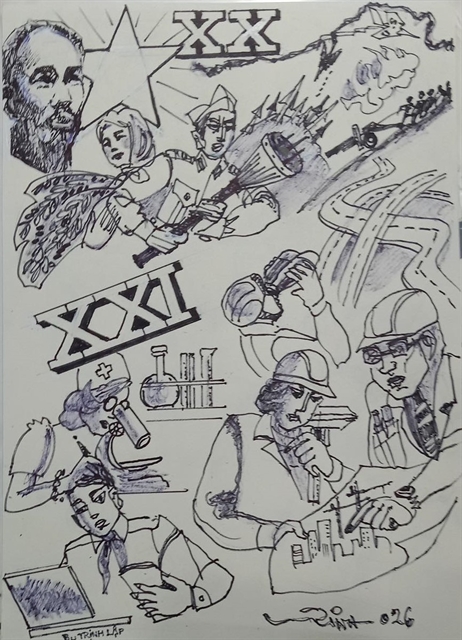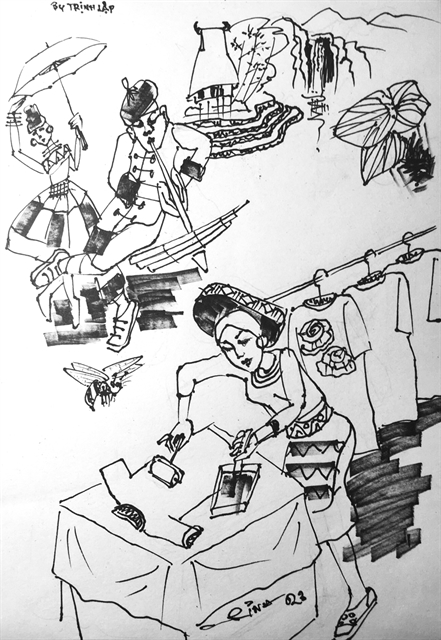 Talk Around Town
Talk Around Town

 |
| Illustration by Trịnh Lập |
by Nguyễn Mỹ Hà
The culture ministry has announced the panpipe music and the art of using beewax to create patterns on cloth of the Mông ethnic minority people in Yên Bái Province as "National Intangible Cultural Heritage".
Occasioned by the announcement Yên Bái authorities opened the Mông Panpipe Festival and Wild Peach Flower Festival 2023 in Mù Cang Chải, Trạm Tấu and Văn Chấn districts last weekend.
The Mông of the northern mountainous provinces have continued many of their traditions, and both of these arts have now been listed in the culture ministry to be intangible assets not only of the Mông, but also protected at the national level.
The recognition of the pan flute of the Mông is not only aimed at preserving their indispensable folk instrument, but also encourages them to continue their traditions not only for spiritual ceremonies, but to allow visitors and tourists to observe this art and take part in local activities.
The pan flute is a wind instrument for the Thái, Mường and Mông peoples. It consists of several bamboo tubes arranged together and connected on one end to a wooden sound box. It can have 6, 12, or 14 bamboo tubes attached.
In the Mông language, they call it "Khềnh", the panpipe that is close to a Mông life from birth to death.
The pipe lute is closely associated with the Mông men, who blow it not only to make music, but also to express their feelings and be connected with the spiritual world. The sound of the pan flute reflects the souls of the Mông men where they show their feelings, both happiness and sorrows.
While the panpipe signifies the man's presence in Mông culture, the beewax prints on cloth represent the women's work and symbolic souls of the Mông and how they see the world and the universe. The wax printing process on cloth is entirely manual and the traditional motifs reflect the Mông's concept of the world, be it on women's clothing, blouses and skirts, or baby holders, blankets, and pillows.
Today Mông women also use beewax print cloth to make bags, wallets, table runners, or cushion pillows for tourists.
With nearly 1.4 million people, the Mông are the fifth most populous people in Việt Nam. They live on the highest mountain, mostly at 1,000m above sea level and higher. Most are in the northern mountainous provinces, having migrated from southern China between 300 and 500 years ago. They also live in the west of Thanh Hóa, Nghệ An, and the Central Highlands.
According to Trần Thu Thủy of the Việt Nam Museum of Ethnology, the Mông know how to turn steep mountain slopes into terraced fields. They carried soil from the lowlands up the mountains to plant rice and maize. Their resilience helps them survive in any circumstance and can be as creative as they often think of new ways of farming or create new habits to fit their new living conditions.
The Mông believe that everything has a spirit, and their houses are furnished accordingly: the genie of the door, the house poles, the kitchen god, and the house ghost are all said to protect them from all these unseen powers.
To carry on the panpipe music or beewax printing traditions, the roles of community master artisans must be mentioned and praised.
Artisan Emeritus Mùa A Thào is the pride of Mông people in the mountains of Hồng Thu, Tả Ngảo and Sà Dề Phìn hamlets in Lai Châu Province. When he was 15, he was dubbed the best panpipe player in his village.
After the victory of Điện Biên Phủ battle in 1954, he went to school to learn how to read and write in national Vietnamese language, left home to work in the Youth Worker Union, and finally moved back to be a commune official.
Today, Thào spends his time making the best panpipe he can and passing on the treasure of the folk music to the younger generation. The Mông in Sìn Hồ have 48 traditional panpipe music pieces that must be recorded, learned, and passed on.
The music of the panpipe accompanies the Mông during their joy and sorrow, and when they die, the music shall accompany them into the afterworld. Thào's apprentice Giàng A Phổng, 40, is next in line to carry on the torch of keeping the traditions for the future.
The Mông has divided into smaller groups who live scattered on the mountain tops. Not far from Lai Châu, artist Giàng A Sử in Tủa Chùa District of Điện Biên Province has also spent his whole life playing the panpipe.
No pan flute maker cannot play it. For the Mông, the pipers are also the instrument makers. They know how it should sound, know the bamboo groves around the village, and can fetch the best bamboo tube and pine wood to make the finest instruments.
All artisans procure their craftsmanship from their teens as a way to express themselves and confirm their identity as proud Mông men. They then learn how to make a pan flute from their fathers, and often spend the rest of their lives refining the art of playing and the craft of making the instrument. VNS




